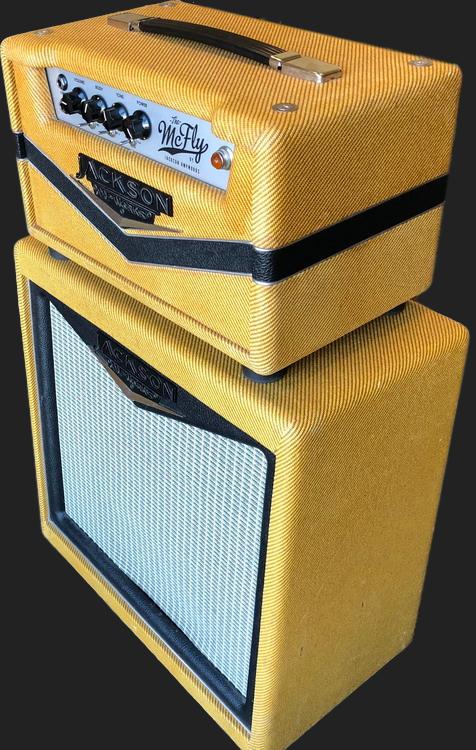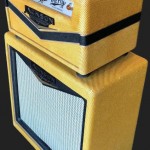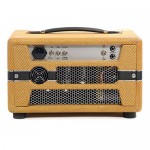THE MCFLY MKII
The McFly from Jackson Ampworks is the first amplifier to be released in our new American Series line and is our take on the best sounding and most flexible Tweed Style amp ever made. For the first time ever, you can get authentic Tweed era tones as well as Blackface era tones all from the same amp!
Available in a head or combo configuration. Black and Ivory, Hot Scarlett and Ivory and Vox Fawn and Ivory are standard colors. Call for quote for all other colors.
MKII UPDATES.
At the urging of several customers of the original McFly for more clean head room from the 60’s mode, we developed a couple of mods that we refer to as the “clean” mods. Essentially those two mods involve lowering the gain of the 60’s mode to allow more contrast between the 50’s and 60’s mode and modifying the power supply to allow for more clean headroom and global dynamic response.
DESIGN GOALS.
From the ground up, the McFly was designed as an original circuit and not a clone of anything that’s been done before. I wanted to design an amp that gave a nod to those very early tweed style amps from the 1950’s but in doing so overcome some of the limitations and shortcomings that are inherit in many of those amps. To make the McFly more flexible I wanted to give the player access to some of the cleaner tones and greater headroom that were found in the blackface era amps of the 1960’s.
Accomplishing these two goals was done over an 18 month long period of design/redesign/tweaking and testing with some of the greatest players in the industry until we felt that the McFly had achieved a unique voice all its own.
FEATURES.
The McFly very proudly features a 6SN7 preamp tube as well as a 6SN7 phase inverter tube. This 8 pin preamp tube was the precursor to the modern 9 pin 12AX7 style preamp tubes that are common now and is in large part why the McFly has the wide frequency response it has. With the McFly, your low-end will remain crystal clear and punchy at frequencies well past the low E string on your guitar and your high end will breathe with the openness and air of a studio grade preamp as these unique preamp tubes allow the full voice of your instrument to be heard.
This preamp, which has two operating modes (50’s and 60’s) gives you two distinct preamp modes with which to sculpt your tone. The 60’s mode is the cleaner of the two modes and will give you more clean headroom and is perfect for musical styles where a warm vintage Blackface type clean tone is needed. The 50’s mode is more aggressive and has more preamp gain which gives the McFly its signature Tweed era tone! In the 50’s mode you’ll notice that notes sustain longer and will often take off into controlled feedback at will.
TONE CONTROLS.
Instead of a typical Treble and Bass control like you’ve seen on other amplifiers, the McFly features a unique set of controls to tailor the frequency response of the amplifier. To control the low end frequency response of the amplifier, we have included a 6-position Body Switch which allows the player to select various configurations of components to sculpt the amount of low-frequency in their tone. Using a switch to control the frequency response provides an intuitive and more repeatable method of dialing in your low-end and reduces loading on the guitars signal which results in a more natural and open tone like you’d find in a studio grade preamp.
In addition to the Body Switch, the McFly features a master Tone control that effects the high frequency of your tone. Much like the tone control on a guitar, the Tone control on the McFly allows the player to dial in a tone that is brighter at the clockwise position and darker at the full counter-clockwise position. The McFly also offer a Bright switch which further extends the high frequency boost when needed.
OUTPUT TUBES.
To complement the 6SN7 preamp we have chosen to run a unique set of power tubes in the McFly. The McFly features two cathode biased 6V6 power tubes which allows the player to get the classic clean tones of a Blackface Deluxe amplifier in the 60’s mode or the aggressive rhythm tones of a Tweed Deluxe in the 50’s mode. The McFly also includes a cathode biased pair of 6L6-GC power tubes which offer a higher wattage clean tone in the 60’s mode and a more robust overdrive tone in the 50’s mode. If you’re familiar with Jackson Ampworks you know that we typically don’t leave well enough alone. We always expand a players tonal palette and offer more than they expect and we’re proud to say that with the release of the McFly, that tradition has continued. To help you create a host of new tones that blur the lines between Blackface and Tweed, the McFly allows the player to select both types of power tubes simultaneously! This feature allows the player to blend the rock solid and dynamic response of the 6L6-GC power tubes with the softened compression of the 6V6 power tubes to create a hybrid tone that is uniquely their own!
OUTPUT POWER FOR EACH POWER MODE:
Clean Overdriven
6V6 13W 18W
6L6-GC 25W 40W
BOTH 46W 70W
POWER SCALING.
To round out the feature set for the McFly and to make the amplifier more useful in volume sensitive environments, we have included power scaling with the McFly. Power scaling allows the player to adjust the output power of the amplifier from max power (depending on power mode) to 1/8th of a watt! This feature allows the player to get true output tube distortion at a fraction of the original volume and will actually help to extend the life of the power tubes as they are not being run as hard when in the power scaling mode!
To guarantee reliability and that your tone is never restricted, we have custom designed an enormous 200W Output Transformer that couples the power tubes of the McFly to your speaker cabinet. Having an output transformer that is 3 times over-spec’ed first guarantees that you’ll never destroy it now matter how hard you run the amp, and second that every bit of tone that is created by the power tubes will be transmitted perfectly to your speaker cabinet will no loss of low end or high end. With our new 200W output transformer you will maintain the entire frequency response of the amplifier regardless of how loud you run the amp! Compare this with most amplifiers that lose low-end and high-end definition at high volumes and cause the mid-range to “bunch up” and lose overall clarity.
We are very proud of the McFly and feel that it is a very worthy conclusion to the over 18 months of design, engineering, testing, development and tweaking we have done to bring you the first amplifier in our new American Series line!
OPEN BACK. OPEN TONE.
As guitarists we work very hard to achieve great tone and certainly one of the most important aspects of that tone is the speaker cabinet that we use. After all, the speaker cabinet is the final link between your amplifier and your ears, therefore its effect on your tone cannot be understated.
It is with this in mind that we are proud to introduce our new line of Open Back Speaker Cabinets! We’ve made several improvements to the way open back speaker cabinets have been built in the past and the results are staggering!
DECEPTIVELY SIMPLE.
When designing the 1×12 Open Back Cabinets we paid very close attention to the size of the cabinet as well as the ratio of the height, width and depth. All of these factors work together to shape the final tone and resonant frequency produced by the cabinet and we’re happy to say that we’ve designed a cabinet that actually has the low end of our Dual Ported cabinets but still retains the signature highs and airiness of an open back cabinet.
One of the critical components of any speaker cabinet, and certainly so with the an open back speaker cabinet design, is the baffle that the speaker physically mounts to. This piece of the cabinet is not only what the speaker mounts to but also how the vibrations from the speakers are transferred into the rest of the speaker cabinet. Too thick of a speaker baffle and the cabinet can sound stiff and restricted; too think of a speaker baffle and the low-end will suffer. Again we experimented with this a great deal to arrive at a material thickness that translates all of the low end content we were looking to convey and still breathes in a natural way.
The most famous open back cabinets ever made were made not to reproduce a certain tone, but were instead designed for economy and speed of manufacture. While it is very inexpensive to manufacture these cabinets, the side effect of cutting corners is a dramatic loss of low-end content. So much so that the maker of these cabinets would have to increase low-end focus on the amplifiers in order to compensate for the lack of low-end response in their cabinets. Try This! Take an American Styled amp from the 60’s, disconnect the speaker lead from the combo and plug it into a well made speaker cabinet – either open back or closed back. There’s a good chance you’ll find that you have WAY too much bass in your tone and will have to turn the Bass control either way down or almost completely off. This is because the standard speaker baffle design that has been used for years is extremely ineffective.
There is a more costly downside to this oversight other than just having to adjust the Bass control on the amp. It takes power to reproduce low end. That is why you’ll seldom see a bass amp less than 60W any many times you’ll see solid state amps producing 1000W or more. The reason is that it takes a lot of power to reproduce low end cleanly. When your cabinet design is inefficient, you have to generate more low end in the amplifier which means that for a given volume your tone will be more overdriven that you may like. In short, it means you have to make compromises in the amplifier design to maintain low end, and the more low end you push from the amp, the more headroom you lose. Conversely it means that if you design the cabinet correctly, and it will accurately deliver the low end that is sent to it, you can remove some low end from the amplifier circuit and the amp will remain cleaner longer than it normally would with a poor speaker baffle design.
So how did we mount our speaker baffle? In order to mount the speaker baffle into the cabinet so that it would be mechanically secure (no rattles or buzzing!) and acoustically efficient, we chose to dado the entire speaker baffle along all four sides of the cabinet. As the cabinet is being assembled, three of the four sides of the cabinet are assembled using their dovetail joints and once they are together, the dado is filled with glue and the speaker baffle is installed. Once the speaker baffle is mounted into the cabinet, the 4th side of the cabinet is installed thus trapping the speaker baffle into position and supporting it on all four sides. Once the cabinet is dried, the speaker baffle is now part of the cabinet as a whole and cannot be removed. This construction method is more time consuming and costly than traditional methods, but the results speak for themselves.
Final tuning of the cabinet was done using the port located on the back panel of the cabinet. Again every little thing matters including the size of an opening on the back of a speaker cabinet. We also found that the location of the speaker on the speaker baffle made a huge difference in tone. We found that dead center was not the sweet spot in this cabinet design and several test baffles were made with the speaker mounted in various locations until the best sounding location was found.
Very seldom are well designed products as simple as they appear. In fact that is one of the hallmarks of a well designed product. It looks simple. There is usually a lot of experimenting and study involved until the desired result is achieved and our speaker cabinets are no different. Every little thing matters and everything we do has a specific reason and I can’t imagine doing it any other way. We exist to elevate our industry and to build the best sounding and most inspiring products possible even if on the surface it looks like a simple wooden box.
CONSTRUCTION DETAILS.
Like all of our cabinets, our Open Back Cabinets are constructed using 13-ply Baltic Birch and feature Dovetail joints for unparalleled strength, rigidity and tone. Also included is a steel strap handle, a genuine Switchcraft jack for reliable operation and 12AWG speaker wire for unrestricted tone and performance.




